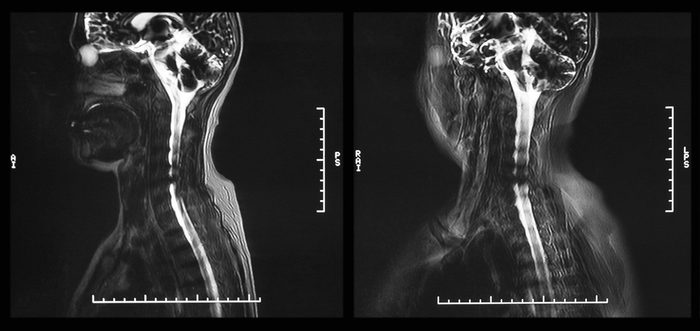
What’s Wrong with Me?
The patient: Chris (name changed), a 38-year-old insurance broker
The symptoms: Debilitating headaches when standing
The doctor: Dr. Christine Lay, neurologist at the Centre for Headache, Women’s College Hospital, Toronto
Chris played hockey, golfed, skied and coached his kids’ sports teams in their Toronto neighbourhood. Then, in 2008, he caught a nasty case of a common virus. It took all summer to recover, but then one of his symptoms, ongoing headaches, persisted.
The pain was excruciating and unrelenting. The headaches came on immediately whenever Chris stood up or even sat up in bed. The only position that brought relief was lying flat, preferably with his head lower than the rest of his body. Even bending over to tie his shoes brought on instant agony. When his toddler put his arms up to be held, it broke Chris’s heart that he couldn’t bend down and pick him up.
Any exertion, like cheering at a sports event, also brought on the suffering. “Sneezing or coughing would be like putting a spike through my eye,” Chris says.
His family doctor sent him to a neurologist, who believed these were migraine headaches and gave him medications that didn’t help. Chris, who’d had occasional migraines sincre his teens, knew these felt different. A CT scan and MRI of his brain showed no tumour, and a second neurologist could offer no additional theories. “People were sort of shrugging their shoulders, saying, ‘I hear what you’re saying and can see how it’s affecting you, but I don’t know how to connect the dots,’” says Chris.

After 15 Months, a Clue
A friend told Chris about Dr. Christine Lay, a neurologist who specializes in headache disorders at Women’s College Hospital. He got a referral but faced a 15-month waiting list. “Headache is the second-leading cause of disability worldwide, but there’s only a handful of physicians who treat these patients,” says Lay.
In the meantime, Chris’s life was falling apart. “Everything was hard,” he says. He avoided dinner parties and travel. He worked but spent most of the day flat on his back on the boardroom table, dangling his head off the edge while making calls. Sometimes he couldn’t make it home. “I’d get that call: ‘Come get me,’” says his wife, Amy. “He’d be a block and a half from the house. His face would be grey and strained.”
Chris finally met with Lay in early 2010. To her, these sounded like low-pressure headaches, brought on by a decrease in the cerebrospinal fluid (CSF) cushioning the brain. When the brain loses buoyancy, it sags, tugging painfully at the membranes around it. Lay suspected that Chris was leaking fluid somewhere in his spinal canal.
CSF leaks are significantly underdiagnosed because they’re often missed on standard brain imaging. Lay ordered a specialized MRI that looks at blood vessels. While she couldn’t spot a leak, she could see that the veins were engorged—a telltale sign the body is trying to send more blood to compensate for the fluid loss around the brain.
Although Chris now had a likely explanation, his headaches couldn’t be cured while the source of the leak remained a mystery. Exploratory surgery was out of the question; any accidental damage to the spinal cord could be irreversible. Lay and Dr. Richard Farb, a neuroradiologist who has since become an expert in imaging CSF leaks, tried multiple X-rays with contrast dye—called myelograms—over several years as the technology improved, but found nothing. “They told me, ‘We can’t fix what we can’t find,’” says Chris.
But Lay says, “I was raised to think that there’s always hope. I never say, ‘I’m done, there’s nothing else to do.’”
Here are 20 symptoms you should never ignore.

An Innovative Procedure
Lay suggested Chris try various approaches that sometimes helped other patients in pain, including meditation, acupuncture and medications. Then, in 2014, Lay sent Chris to Los Angeles for a surgery to alleviate his symptoms. The doctor reduced the protective sheath at the bottom of Chris’s spine, forcing more fluid back up to the brain. It helped for two years.
Farb, who went along to learn, saw the team doing myelograms with patients lying on their fronts, not just their backs, allowing the dye to drain in different directions and making certain leaks easier to find. By the time Chris’s headaches returned at full force, Farb had innovated further and was doing myelograms with patients on their sides.
In March 2018, as Farb reviewed Chris’s latest imaging, he thought he saw the tiniest anomaly. He called Chris in for some fresh scans. “He had me buckled onto a gurney that he was turning and tilting,” says Chris. “Then he said, ‘There it is!’ I’ll never forget it. We were in tears.”
Chris’s CSF was draining through a defect on the right side of his spinal canal, around the middle of his back, and an abnormal vein connection was carrying it away, into the circulatory system. This type of CSF leak is called a venous fistula, and it’s impossible to know for sure what caused it in Chris.
In May of that year, Chris returned to L.A. for a surgical repair. During recovery, he still had pain at first; he’d been overproducing fluid for 12 years and now the pressure was too high. But after a few weeks on diuretics, Chris’s headaches were gone at last.
CSF venous fistulas, once so elusive, can now be found in 90 percent of patients who have them, thanks to the improved techniques. Chris is grateful to be among the success stories. “I don’t really have words,” he says. “When I was sick, I wasn’t as good a husband and I wasn’t as good a father. I got it all back.”
Next, check out the medical mystery that will make you think twice about how you dress your bed.